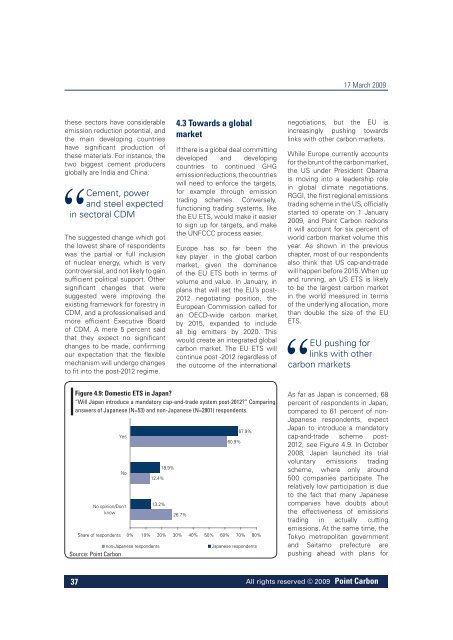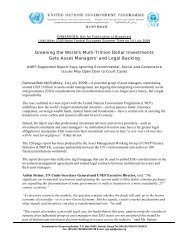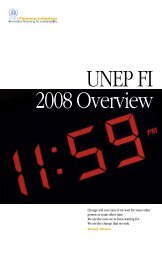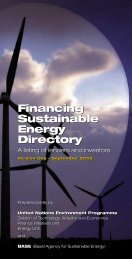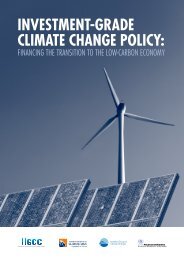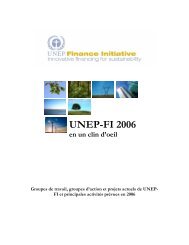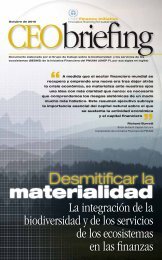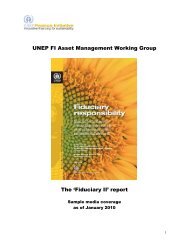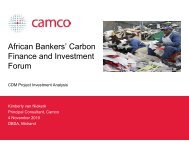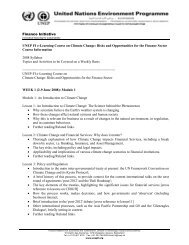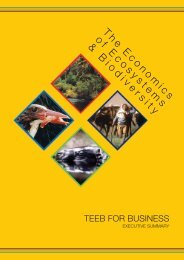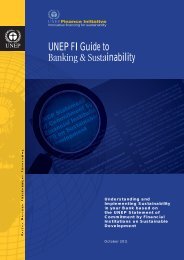Carbon 2009 Emission trading coming home - UNEP Finance Initiative
Carbon 2009 Emission trading coming home - UNEP Finance Initiative
Carbon 2009 Emission trading coming home - UNEP Finance Initiative
You also want an ePaper? Increase the reach of your titles
YUMPU automatically turns print PDFs into web optimized ePapers that Google loves.
17 March <strong>2009</strong><br />
these sectors have considerable<br />
emission reduction potential, and<br />
the main developing countries<br />
have significant production of<br />
these materials. For instance, the<br />
two biggest cement producers<br />
globally are India and China.<br />
Cement, power<br />
and steel expected<br />
in sectoral CDM<br />
The suggested change which got<br />
the lowest share of respondents<br />
was the partial or full inclusion<br />
of nuclear energy, which is very<br />
controversial, and not likely to gain<br />
sufficient political support. Other<br />
significant changes that were<br />
suggested were improving the<br />
existing framework for forestry in<br />
CDM, and a professionalised and<br />
more efficient Executive Board<br />
of CDM. A mere 5 percent said<br />
that they expect no significant<br />
changes to be made, confirming<br />
our expectation that the flexible<br />
mechanism will undergo changes<br />
to fit into the post-2012 regime.<br />
4.3 Towards a global<br />
market<br />
If there is a global deal committing<br />
developed and developing<br />
countries to continued GHG<br />
emission reductions, the countries<br />
will need to enforce the targets,<br />
for example through emission<br />
<strong>trading</strong> schemes. Conversely,<br />
functioning <strong>trading</strong> systems, like<br />
the EU ETS, would make it easier<br />
to sign up for targets, and make<br />
the UNFCCC process easier.<br />
Europe has so far been the<br />
key player in the global carbon<br />
market, given the dominance<br />
of the EU ETS both in terms of<br />
volume and value. In January, in<br />
plans that will set the EU’s post-<br />
2012 negotiating position, the<br />
European Commission called for<br />
an OECD-wide carbon market<br />
by 2015, expanded to include<br />
all big emitters by 2020. This<br />
would create an integrated global<br />
carbon market. The EU ETS will<br />
continue post -2012 regardless of<br />
the outcome of the international<br />
negotiations, but the EU is<br />
increasingly pushing towards<br />
links with other carbon markets.<br />
While Europe currently accounts<br />
for the brunt of the carbon market,<br />
the US under President Obama<br />
is moving into a leadership role<br />
in global climate negotiations.<br />
RGGI, the first regional emissions<br />
<strong>trading</strong> scheme in the US, officially<br />
started to operate on 1 January<br />
<strong>2009</strong>, and Point <strong>Carbon</strong> reckons<br />
it will account for six percent of<br />
world carbon market volume this<br />
year. As shown in the previous<br />
chapter, most of our respondents<br />
also think that US cap-and-trade<br />
will happen before 2015. When up<br />
and running, an US ETS is likely<br />
to be the largest carbon market<br />
in the world measured in terms<br />
of the underlying allocation, more<br />
than double the size of the EU<br />
ETS.<br />
EU pushing for<br />
links with other<br />
carbon markets<br />
Figure 4.9: Domestic ETS in Japan?<br />
“Will Japan introduce a mandatory cap-and-trade system post-2012?” Comparing<br />
answers of Japanese (N=53) and non-Japanese (N=2801) respondents.<br />
No opinion/Don't<br />
know<br />
Share of respondents<br />
Yes<br />
No<br />
12.4%<br />
13.2%<br />
non-Japanese respondents<br />
Source: Point <strong>Carbon</strong><br />
18.9%<br />
26.7%<br />
60.9%<br />
67.9%<br />
0% 10% 20% 30% 40% 50% 60% 70% 80%<br />
Japanese respondents<br />
As far as Japan is concerned, 68<br />
percent of respondents in Japan,<br />
compared to 61 percent of non-<br />
Japanese respondents, expect<br />
Japan to introduce a mandatory<br />
cap-and-trade scheme post-<br />
2012, see Figure 4.9. In October<br />
2008, Japan launched its trial<br />
voluntary emissions <strong>trading</strong><br />
scheme, where only around<br />
500 companies participate. The<br />
relatively low participation is due<br />
to the fact that many Japanese<br />
companies have doubts about<br />
the effectiveness of emissions<br />
<strong>trading</strong> in actually cutting<br />
emissions. At the same time, the<br />
Tokyo metropolitan government<br />
and Saitamo prefecture are<br />
pushing ahead with plans for<br />
37<br />
All rights reserved © <strong>2009</strong> Point <strong>Carbon</strong>


